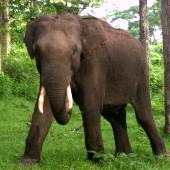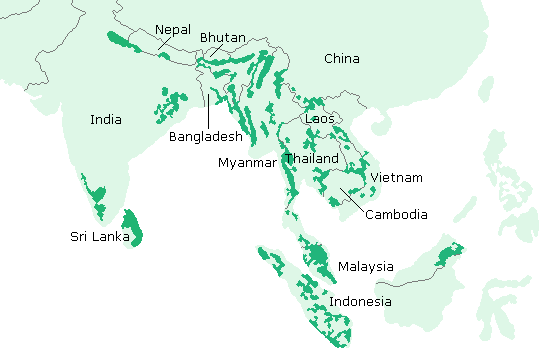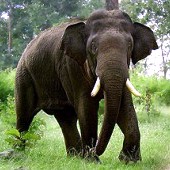|
Classification
There are two major types of elephants, the African Elephant (Loxodonta africana) and the Asian Elephant (Elephas maximus). African Elephants are the biggest land animals, Asian elephants are slightly smaller. Elephants are the only living representatives of their order, which was once widespread over the world and included the mammoth and the mastodon:
Kingdom Animalia
Phylum Chordata
Subphylum Vertebrata
Class Mammallia
Order Proboscidea
Family Elephantidae
Genus Elephas
Species Elephas maximus
Evolution
The elephant family shares distant ancestry with the sea cows and the hyraxes. In the distant past, members of the hyrax family grew to large sizes, and it seems likely that the common ancestor of all three modern families was some kind of amphibious hyracoid.
Conservation status
The Asian elephant is classified as Endangered by the International Union for the Conservation of Nature and Natural Resources (IUCN) Red List and is listed on Appendix 1 of the Convention on International Trade in Endangered Species of Wild Fauna and Flora (CITES). In past centuries Asian elephants have been killed for their ivory tusks. Due to the slaughter of elephants to attain ivory, and the loss of their habitat, they are endangered. The IUCN's Species Survival Commission's Asian Elephant Specialist Group estimates that there are approximately 35,000 wild Asian elephants (2004). In comparison, there are more than 600,000 African elephants. Perhaps the Asian elephants' decline has been less noticeable because it has been more gradual.
Geographic Range and Habitat
The habitat of Asian elephants is restricted to the Indian peninsula and Southeast Asia. They live in many different habitats including open grasslands, marshes, tropical savannah, tropical rainforest, tropical deciduous forest, mountains (Himalayas) in the countries India, Nepal, Bhutan, Bangladesh, Sri Lanka, Myanmar, Thailand, Cambodia, Laos, Vietnam, China, Malaysia and Indonesia. The loss of habitat is the primary threat to Asian elephants. Approximately 25% of the world's population lives in or near the range of Asian elephants. The homes of these elephants are being cleared for reasons like agricultural development and human settlement.
Diet
Asian elephants are the second largest herbivores (plant eaters) and feed most of their time. They need great quantities of food to sustain their massive size. Using their tusks and trunk to get food, they feed sixteen hours a day, eating about 220 to 400 lbs (100 to 180 kg) of grasses, roots, leaves, trees, shoots, bark, bamboo, branches and shrubs and drink up to 40 gallons (150 liters) water per day. They also produce huge mounds of manure that contain nutrients on which birds and other creatures feed. To process its highly fibrous food the elephant makes use of a large cecum, which ferments the food and allows micro-organisms to aid in digestion. But the digestive system of elephants is less efficient than those of other herbivores. Food passes quickly through the digestive system before nutrients are absorbed, causing elephants to discard about half the plant material they consume, the rest is excreted unchanged. This inefficient digestive system means that elephants must eat large quantities of food to retain and absorb necessary nutrients for good health.
Elephant herds can quickly deplete the food and water resources of an area, forcing them to keep on the move. A herd of elephants walks seasonally in an extended loop, looking for fresh resources within its home range, which can extend over 500 sq mi (1.300 kmē). Walking at a normal pace an elephant covers about 2 to 4 mph (3 to 6 km/h) but they can reach 24 mph (40 km/h) at full speed.
Anatomy and Physical Description
Asian elephants are from 9 to 10 ft (2,70 to 3,00 m) tall at the shoulder and weighing between 7,700 and 11,000 lbs (3.500 to 5.000 kg). Their length is about 18 to 23 ft (5,50 to 7,00 m). Males are larger than females. Large Asian bull elephants reach up to 11 ft (3,35 m) in shoulder height, weigh about 13,200 lbs (6.000 kg) and its tusks are up to 6 ft (180 cm) long. Females average about 8,400 lbs (3.800 kg). The female of this species has no or only small tusks. Despite their size, elephants are agile and graceful in their movements. Their life span is up to 65 years in captivity. The longevity of an elephant in the wild is about 55 years. Their closest living relative is the African elephant. In comparison an Asian elephant has small ears, a rounded back, smoother skin, and only one finger on its trunk. They cannot jump and so cannot pass wide or high barriers, but readily take to rivers and lakes, where the water supports them and enables them to swim long distances without tiring. The Asian elephant has 5 toes on the foreleg and 4 toes on each hind leg. The male elephant has internal testes.
Skull: The elephant skull has developed great size to support the massive trunk and the heavy dentition. Air spaces and sinuses fill the skull to make it lighter, and allow the elephant to communicate using a low growl referred to as an "infrasound" that carries for miles.
Skin: Elephants have gray skin that is sparsely covered with hair and only 0.8 to 1.6 inches (2 to 4 cm) thick. To protect their skin elephants cover themselves with dust and by taking mud baths. Without regular mud baths to protect it from burning, as well as from insect bites and moisture loss, an elephant's skin would suffer serious damage. After bathing, the elephant will usually use its trunk to blow dirt on its body to help dry and bake on its new protective coat.
Ears: The ears not only hear well, but also help the elephant lose excess heat, as hot blood flows near the surface and the ears act as radiators to regulate temperature. Each ear contains many blood vessels, and the blood is cooled as the elephant flaps its ears. On hot days, elephants will flap their ears constantly, creating a slight breeze. This breeze cools the surface blood vessels, and then the cooler blood gets circulated to the rest of the animal's body.
Teeth: Elephants' teeth are actually very different from those of most other mammals. Elephants have four teeth, all molars, which have jagged ridges for grinding the plant material. The first pair of molars is located toward the front of the mouth. When these front molars wear down, they drop out in pieces as the two molars in the back shift forward. Two new molars then emerge in the back of the mouth to replace those that have moved forward. Over their lives they have 26 teeth, including two upper incisors (tusks), and 24 molars. Unlike most mammals, which grow baby teeth and then replace them with a permanent set of adult teeth, elephants have cycles of tooth rotation throughout their entire life. The 24 molars are replaced six times in an elephant's life. When the last set of molars wears out, at about 55 years of age, an elephant can no longer chew food and dies of starvation, a not uncommon death. When an elephant becomes very old, the last set of teeth become brittle, and it must rely on softer foods to chew.
Trunk: Elephants breathe through two nostrils at the end of their trunk, which is an extension of the nose. The trunk is a useful and muscular appendage that enables an elephant to reach food in high places and lift obstacles weighing up to 880 lbs (400 kg). With over 100,000 muscles, the elephant's trunk is also very versatile. With it an elephant smells, picks up food and gets water. Elephants drink by sucking water into the trunk and squirting it into the mouth. They also use the trunk to spray themselves water and dust onto their backs for cooling or protection from flies, to greet each other, and to vocalize. The trunk has a prehensile extension at the tip, which it uses like finger. It allows elephants to grasp objects much as humans do with their fingers.
Breeding
The gestation for an elephant is about 22 months (630 to 660 days), the longest gestation period of all mammals after which one calf typically is born. Twins are very rare. When adult male elephants search for a female to breed with, they produce musth fluid signaling females that they are ready to mate. Female Asian elephants are capable of giving birth approximately every 3 to 5 years. During the birth of a calf the members of the herd will gather around to help the mother. When born, a calf weighs about 200 to 260 lbs (90 to 120 kg) and is about 3 ft (90 cm) high, just tall enough to reach its mother's nipples. It nurses by mouth on one of the nipples located between the forelegs and gains 2 to 2.5 lbs (about 1 kg) a day. Baby elephants are raised and nurtured by the whole family group, practically from the moment they are born. A calf may nurse for up to 2 years of age or older.
If the calf is female, she will stay with its mother's herd all her life and reach sexual maturity at around 8 to 10 years of age and become pregnant for the first time around age 11. Female elephants come into estrus, or heat, every 3 months, at which time they are receptive to mating. While pregnant, a cow's estrus cycle halts and she does not mate. Soon after a cow gives birth, her estrus cycle begins again and she mates even if she is nursing. They can reproduce until ages 45 to 50 and there is no breeding season for elephants. If the calf is a male, he will leave the herd and join a small group of other males when it is about 12 years old. Males reach sexual maturity around age 10, but they are not large and strong enough to compete with other males for breeding until they are in their mid-twenties.
Communication
Asian elephants talk to each other by touch, sound, scent, and body language. Touching is done mainly with the trunk, and can range from a cow's gentle caress of her calf to a disciplinary slap delivered by a matriarch to an unruly young male. Elephants also use a broad range of sounds to communicate, like trumpeting as a warning or greeting to other elephants nearby. They also produce low-frequency rumbling sounds, which can travel over great distances, reaching the ears of elephants several kilometers away. Elephants also communicate with infrasound, sounds inaudible to human ears. They also may use the secretion of different pheromones in urine or dung. These chemical scent signals can be detected by nearby elephants, or carried by the breeze to elephants at a distance. The secretions of the glands during musth also convey scent messages, a signal to local females that males are ready to reproduce. In addition, information is shared through various body poses.
Musth
Males will go into musth, a period where the testosterone level is high and the behavior is extremely aggressive. When a bull is about 20 to 25 years of age, the large glands on both sides of its head begin to swell and secrete an oily, testosterone-rich fluid. This sometimes signals an increase in breeding behavior. Males will compete for the chance to breed. This event occurs annually throughout the bull's lifetime, lasting for several weeks or several months depending on the animal's condition.
Social Behavior
Elephants live in a very structured social order. The social lives of male and female elephants are very different. Female elephants have very strong social bonds and live in matriarchal families. The herds are matriarchal with the oldest, most experienced female in charge, so that the herd may benefit from her accumulated knowledge of the home range. The matriarch has the best knowledge of food and water sources. When the elder cow in a family dies, the next oldest cow usually takes her place as leader.
An elephant herd consists of mothers, grandmothers, sisters, aunts and their offspring. They are very cooperative and protective of the group and will protect and care for the young, all of them help raising babies. Families range in size from 5 to 30 individuals. These animals may remain together for life. If a family becomes too large, a few females leave to start a new herd. Males occasionally join the group.
Most time the elephants forage in the cool part of the day, and rest in the shade in the heat. Since they consume such a huge amount of food they need to travel great distances. Elephants are spraying water and dirt on their back to keep cool and clean, as well as to rid themselves of insects. Elephants have a need to be by water and are excellent swimmers. They are able to cross water ways by using their trunks as a snorkel.
Young males begin to wander away from the family at about age six, and gradually spend more and more time away, alone or in the company of other young males. When they become sexually mature they either leave the family for good or are driven away by the older females. Male Asian elephants live alone or in male only groups. They will sometimes come together in bachelor herds, but these are usually a more loose association. The males spend much more time than the females fighting for dominance with each other. Only the most dominant males will be permitted to breed with cycling females.
|









